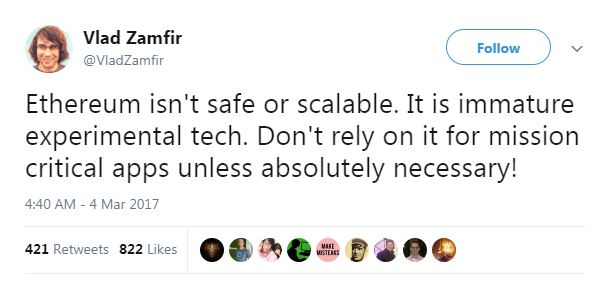The term “Casper” has been popping up lately in the Ethereum community like a whack-a-mole. Despite a so far turbulent year, there is a lot of anticipation of what Casper will do for Ethereum.
With the successful launch of the Casper Testnet on the last day of 2017, excitement in the Ethereum community is gathering the momentum of a runaway freight train.
Still, while everyone revs up for a Casper-supercharged “world computer,” its release date is as elusive and mysterious as a poltergeist, with Ethereum’s developers loosely announcing it will occur some time this year.
But before we get ahead of ourselves, let’s break it down and have a look at Ethereum’s ghostly counterpart.
What is Casper?
Casper is a hard fork of Ethereum that solves many of the underlying issues holding the cryptocurrency back from mass adoption. At its core, Casper aims to enhance Ethereum’s security and reduce the risk of centralization, while eliminating the financially and environmentally unsustainable practice of mining.
Casper marks a shift to the Proof-of-Stake protocol, but it will start out as a hybrid with the current Proof-of-Work. In practice, this means that the PoS will only be used every 100th block. All details are exceedingly vague at this stage, but the eventual outcome of Casper could result in three versions (forks) of Ethereum: PoS, PoW, and Classic.
As we count down to the Casper fork, Ethereum miners are starting to bite their nails. Why? It is highly probable that the transition to PoS will mark the end of Ethereum mining, as ETH’s developers plan to detonate a “difficulty bomb” on the PoW fork when they release Casper. The “bomb” is a piece of Ethereum code that by design makes blocks increasingly difficult to mine. The Casper fork will exponentially speed up this process until the “Ice Age” of mining forecast by Vitalik Buterin in 2021.
What Does Casper Do?
Put simply by its whitepaper, Casper aims to bring “security, reduced risk of centralization, and energy efficiency” to the Ethereum network. To wrap your head around how exactly it will do this, you must appreciate the issues it is solving.
Ethereum operates on the same consensus mechanism as Bitcoin: Proof-of-Work. While this has been an extremely popular tool for a variety of blockchains, you can think of PoW in the same way as a Chevy V8 – reliable and robust, but outrageously inefficient and, well, just plain old.
No one disputes that PoW’s mining process is a gross waste of electricity, not to mention it incurs the risk of a PoW blockchain facing a 51% attack, by which a group of miners join forces to wreak havoc, double-spending and reversing transactions whenever they please.
The developers of Ethereum know all of this too well, which is why they have always planned to make the transition to Proof-of-Stake, which achieves consensus by allowing token holders to “stake” their coins in specialized wallets. In return, stakers will be rewarded by the system, similar to the way you accumulate interest on a savings account at the bank. This process allows the network to achieve consensus without using the mammoth quantities of electricity consumed during mining. It also eliminates the likelihood of a 51% attack, simply by making them far too expensive to attempt.
While figures are yet to be confirmed, Ethereum’s founder Vitalik Buterin alluded that stakers will need to put up 1,000 ETH to participate, so for now Mom and Pop investors may have to make room for the big boys, or join a “stake pool,” a collective effort in which the rewards are split among contributors. The Casper Testnet’s current requirement is a mind-bending 1,500 ETH, so don’t go holding your breath for any discounts.
All of this will speed up Ethereum’s network by enabling faster block creation as well as allowing sharding – the partitioning of a database into smaller, more controllable parts. On the user end, this lower latency will make the network faster and cheaper to use (in theory). Lastly, PoS may reduce the risk of centralization seen with PoW, where wealthy miners can afford to invest in more effective mining gear.
History of Casper
What most people don’t know is that a PoS fork has always been in the pipelines for Ethereum, with the Casper project starting way back in September 2014. Casper is the ghostly little brainchild of Ethereum’s top researcher, Vlad Zamfir, who has bluntly expressed that he thinks Ethereum can do better:

If the name “Casper” conjures up images of an eerie apparition, you wouldn’t be too far off – the team’s inspiration for the name was from “GHOST,” which stands for Greedy Heaviest Observed Sub-Tree, a protocol for transitioning PoW to PoS.
Challenges
It is obvious that Casper marks Doomsday for Ethereum miners, but there are additional challenges that may arise once Casper is implemented.
Handing over the reins to a group of stakers poses many issues. For one, PoS may put the entire Ethereum network at risk of failure in the event of a physical disaster or anti-Ethereum regulation. Hypothetically, if either of these events were to occur in a zone containing all the validators, it could wipe out the entire network. This is not a possibility with PoW, where miners can pick up the ball from outside the affected area.
As there are only up to 250 validators in Casper, the above scenario is entirely possible. Taking down 250 peers is well within the capabilities of hackers and government authorities, and this should be a cause for concern.
Lastly, the whole point of blockchains is that they are decentralized, and staking may subvert this vital quality. The gargantuan quantity of ETH one must hold to be a staker reserves PoS for whales and collaborative staking efforts – both of which are markedly centralized.
Last Thoughts
The Casper hard fork is intended to take the weight off the weary shoulders of the Ethereum network. Relieving it of its wasteful, snail’s-pace PoW consensus mechanism is necessary for Ethereum to make the leap into outer-orbital dominance.
PoS will undoubtedly benefit Ethereum in many ways: by turbo-charging transaction speeds, eliminating wasteful mining practices, and reducing the risk of centralization seen with PoW. That said, there are a number of concerns facing the shift to PoS, all of which will need to be addressed by Buterik and his gang of ghostbusters.
Related: What Is Ethereum?

